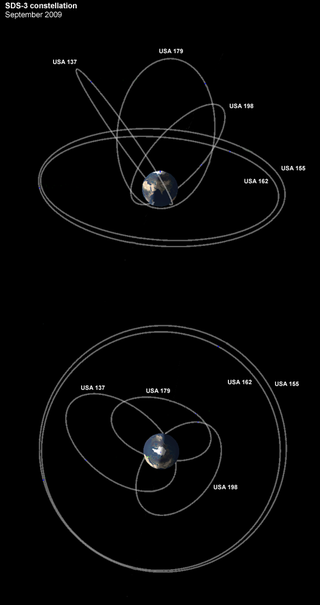Top Qs
Timeline
Chat
Perspective
Satellite Data System
American military satellite communication system From Wikipedia, the free encyclopedia
Remove ads
The Satellite Data System (SDS) is a system of United States military communications satellites. At least three generations have been used: SDS-1 from 1976 to 1987; SDS-2 from 1989 to 1996; SDS-3 from 1998 to the present. It is believed that these satellites were known by the code name Quasar.[1] The first generation was named simply 'SDS', the second generation was named 'Quasar' and the third generation each had their own designations.[2]

Remove ads
Orbital characteristics
SDS satellites have a highly elliptical orbit, going from about 300 kilometers at perigee to roughly 39,000 km at apogee in order to allow communications with polar stations that cannot contact geosynchronous satellites. The high apogee meant that the polar regions were visible for long amounts of time, and only two satellites were required in order to achieve constant communications ability. In addition, two geostationary satellites appear to be part of the system. The SDS satellites were constructed by Hughes Aircraft Company.
Remove ads
Mission
The primary purpose of the SDS satellites is to relay imagery from low-flying reconnaissance satellites, notably the Keyhole optical reconnaissance and Lacrosse/Onyx radar reconnaissance satellites to ground stations in the United States.[3]
SDS-1


Each SDS-1 satellite had 12 channels available for Ultra high frequency (UHF) communication. They were cylindrical in shape, roughly 25 ft (7.6 m) long. 980 watts of electrical power were available from solar panels and batteries. The SDS-1 had a mass of 630 kg (1,390 lb) and was launched on Titan-3B rockets. The SDS-1 satellites had similar orbits to the Air Force's Jumpseat ELINT satellites.[4]
It has been speculated that the early satellites served as data relays for the first KH-11 Kennen reconnaissance satellites.[5]
SDS-2
The SDS-2 is significantly more massive at 2,335 kg (5,148 lb), with three separate communication dishes, including one for a K-band downlink. Two dishes are 4.5 m (15 ft) in diameter, while the third is 2 m (6 ft 7 in) in diameter. The solar arrays generate 1238 watts of power. It is believed that the Space Shuttle has been used to launch several satellites, possibly on missions STS-28, STS-38, and STS-53. Other launches have used the Titan IV launch vehicle.
Remove ads
Satellites
Remove ads
References
Wikiwand - on
Seamless Wikipedia browsing. On steroids.
Remove ads
